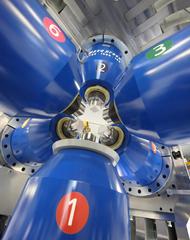URL: https://www.desy.de/news/news_search/index_eng.html
Breadcrumb Navigation
DESY News: Researchers discover cause of puzzling seismic discontinuity
News
News from the DESY research centre
Researchers discover cause of puzzling seismic discontinuity
At a depth of 660 kilometres, there is an abrupt change in the speed at which seismic waves travel through Earth's interior. However, for hitherto unknown reasons this striking seismic discontinuity splits into two below cold subduction zones, where the oceanic crust sinks into the mantle below the continental crust. With high-pressure experiments at DESY's X-ray light source PETRA III and at the Japanese X-ray light source SPring-8, a research team led by the Bavarian Geoinstitute at the University of Bayreuth has now found an explanation for this puzzling phenomenon: the transformation of the mineral akimotoite into bridgmanite. The researchers around main author Artem Chanyshev from DESY and the University of Bayreuth present their results in the journal Nature.

The 4.5-metre-high Large Volume Press weighs in at 35 tonnes and can exert a pressure of 500 tonnes on each of its three axes, which corresponds to 300,000 times the atmospheric pressure or the pressure conditions 900 kilometres below Earth's surface. During compression, the samples' inner structure can be analysed with the bright X-ray light from PETRA III. Credit: DESY, Dirk Nölle
The researchers now found an explanation by studying the phase transition of the mineral akimotoite to bridgmanite under conditions of Earth's mantle with X-rays. Akimotoite exists mainly in the cooler regions of the transition zone. „We loaded mineral samples in our Large Volume Press and analysed them with the bright X-rays from PETRA III while compressing and heating them“, explains co-author Robert Farla, scientist in charge of the beamline P61B where the experiments took place. „This way, we can follow structural changes in the minerals under conditions of Earth's mantle.“
The experiments led to a surprising result: the akimotoite-bridgmanite phase transition exhibits a steep negative Clapeyron slope. This means that the lower the temperature, the higher the pressure has to be for a phase transition into bridgmanite. Higher pressure means a greater depth. Thus, even a comparatively small drop in temperature causes the phase transition from akimotoite to bridgmanite to shift significantly deeper into Earth's interior.
“The very striking seismic discontinuity at a depth of 740 to 750 kilometres below cold subduction zones can be plausibly explained by the akimotoite-bridgmanite phase transition on the basis of our experiments,” explains Chanyshev. The other discontinuity occurring at 660 to 670 kilometres below cold subduction zones is accordingly caused by ringwoodite breaking down into akimotoite and ferropericlase. “Both these transitions can cause the propagation velocity of seismic waves to change abruptly,” says Chanyshev.
Scientists from the Bavarian Geoinstitute at the University of Bayreuth, the Center for High Pressure Science and Technology Advanced Research in Beijing and the Jilin University in Changchun (China), the Japan Synchrotron Radiation Research Institute and the Tohoku University in Sendai (Japan) and from DESY were involved in this work.
Reference:
Depressed 660-km discontinuity caused by akimotoite–bridgmanite transition; Artem Chanyshev, Takayuki Ishii, Dmitry Bondar, Shrikant Bhat, Eun Jeong Kim, Robert Farla, Keisuke Nishida, Zhaodong Liu, Lin Wang, Ayano Nakajima, Bingmin Yan, Hu Tang, Zhen Chen, Yuji Higo, Yoshinori Tange & Tomoo Katsura; „Nature“, 2022, DOI: 10.1038/s41586-021-04157-z
Source: press release from the University of Bayreuth



